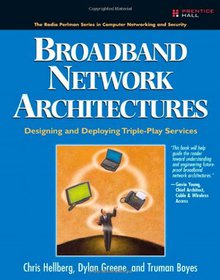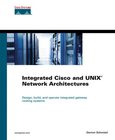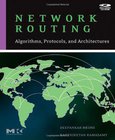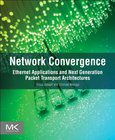Broadband Network Architectures
Designing and Deploying Triple-Play Services

Book Details:
| Publisher: | Prentice Hall |
| Series: | Prentice Hall |
| Author: | Chris Hellberg |
| Edition: | 1 |
| ISBN-10: | 0132300575 |
| ISBN-13: | 9780132300575 |
| Pages: | 600 |
| Published: | May 11 2007 |
| Posted: | Nov 19 2014 |
| Language: | English |
| Book format: | |
| Book size: | 7.61 MB |
Book Description:
'Network professionals who are looking to deploy triple-play service provider networks will find this book a useful tool.' Michael Newbery, IP Architect, TelstraClear Limited 'This book provides a wealth of information on current and future broadband architectures, services, and deployments. It will serve both experienced technical experts needing a comprehensive reference, as well as those needing a concise explanation of broadband access architectures and multi-play services.' Sanjay Wadhwa, Product Line Manager, IP Edge Products, Juniper Networks 'This book is a thorough guide for anyone involved with triple-play networks. Its multivendor approach and references to the latest standards from the DSL Forum and the IETF makes it a must-have for anyone involved in broadband access networks.' Andrea Lasagna, Data Video Services Manager, FASTWEB Service providers are increasingly focused on delivering triple-play bundles that incorporate Internet, video, and VoIP servicesas well as multi-play bundles containing even more advanced services. Broadband Network Architectures is the first comprehensive guide to designing, implementing, and managing the networks that make triple-play services possible. Hellberg, Greene, and Boyes present their field-tested industry best practices and objectively evaluate the tradeoffs associated with key up-front architectural decisions that balance the complexities of bundled services and sophisticated traffic policies. Broadband Network Architectures not only documents what is possible on this rapidly changing field of networking, but it also details how to divide Internet access into these more sophisticated services with specialized Quality of Service handling. Coverage includes An in-depth introduction to next-generation triple-play services: components, integration, and business connectivity Triple-play backbone design: MPLS, Layer 3 VPNs, and Broadband Network Gateways (BNGs)/Broadband Remote Access Servers (B-RAS) Protocols and strategies for integrating BNGs into robust triple-play networks Triple-play access network design: DSLAM architectures, aggregation networks, transport, and Layer 2 tunneling VLAN-per-customer versus service-per-VLAN architectures: advantages and disadvantages PPP or DHCP: choosing the right access protocol Issues associated with operating in wholesale, unbundled environments IP addressing and subscriber session management Broadband network security, including Denial of Service attacks and VoIP privacy The future of wireless broadband: IMS, SIP, and non-SIP based fixed mobile convergence and wireless video Contents Foreword Preface About the Authors Chapter 1 A History of Broadband Networks Chapter 2 Next Generation Triple-Play Services Chapter 3 Designing a Triple-Play Backbone Chapter 4 Designing a Triple-Play Access Network Chapter 5 Choosing the Right Access Protocol Chapter 6 Evolutions in Last Mile Broadband Access Chapter 7 Wholesale Broadband Networks Chapter 8 Deploying Quality of Service Chapter 9 The Future of Wireless Broadband Chapter 10 Managing IP Addressing Chapter 11 Dynamic User Session Control Chapter 12 Security in Broadband Networks Appendix A Glossary of Acronyms and Key Terms Appendix B Glossary of Packet Diagrams Index
Download Link:
Related Books:
Integrated Cisco and UNIX Network Architectures
Design, build, and operate integrated gateway routing systemsLearn how to design, build, and administer integrated gateway routing systemsIdentify the advantages and disadvantages of Cisco/UNIX integrated designsReview lab exercises throughout the book that bring concepts to life Encounter the fascinating world of dynamic UNIX routing and TCP/IP stacksUnderstand the way forwarding and signaling are implemented in the UNIX world Gain proficiency with tunnels and VPNsUtilize advanced features such as high availability, NAT, bandwidth management, policy routing, and multicast architecturesExplore Linux and BSD networking conceptsUNIX gateways introduce massive performance possibilities at a fraction of the price of dedicated proprietary appliances by pe...
Network Routing
Algorithms, Protocols, and Architectures
Network routing can be broadly categorized into Internet routing, PSTN routing, and telecommunication transport network routing. This book systematically considers these routing paradigms, as well as their interoperability. The authors discuss how algorithms, protocols, analysis, and operational deployment impact these approaches. A unique feature of the book is consideration of both macro-state and micro-state in routing; that is, how routing is accomplished at the level of networks and how routers or switches are designed to enable efficient routing.In reading this book, one will learn about 1) the evolution of network routing, 2) the role of IP and E.164 addressing in routing, 3) the impact on router and switching architectures and their design, 4...
Network Convergence
Ethernet Applications and Next Generation Packet Transport Architectures
Network Convergence: Ethernet Applications and Next Generation Packet Transport Architectures provides the guidance and solutions you'll need to understand Ethernet and emerging applications such as cloud computing and mobile apps, as well as large-scale retail and business deployments. This reference starts with an overview of the Ethernet and existing broadband architectures, including XDSL, WIMAX, and VLANs. It moves on to cover next-generation networks and mobile architectures, as well as cloud computing. The book also addresses the convergence of optical, Ethernet and IP/MPLS layers, considered to be the backbone of next-generation packet transport architecture. If you're a network designer or architect, a technical sales professional, or if y...
2007 - 2021 © eBooks-IT.org



